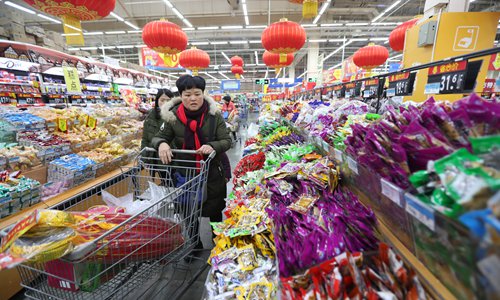HOME >> SOURCE
Large-scale retail stores step up efforts to open smaller stores
Source:Global Times Published: 2019/12/1 14:28:39

A woman looks at goods in a Walmart store in Kunming, capital of Southwest China's Yunnan Province in February 2018. Photo: VCG
Large-scale retail stores in China are stepping up efforts to open smaller-scale stores in various neighborhoods to reach a wider range of consumers, in response to a new pattern of retail consumption amid competition.
Walmart recently announced that it plans to open 500 new stores and depots in China over the next five to seven years, more than doubling its footprint in the country.
Walmart's announcement followed the release of the company's third-quarter earnings, which showed its sales grew 6.3 percent year-on-year, much higher than its 2.5 percent growth worldwide. It is Walmart China's best quarterly result in the last five years, with its Sam's Club as the main contributor.
"Overall, foreign retailers are opening more branches in China this year, featuring more new brands, flagship stores and business models," Gao Feng, spokesperson for China's Ministry of Commerce, told a regular briefing on Thursday.
Although Walmart China has not yet disclosed details of the 500 stores, James Ku, senior vice president of Realty with Walmart China, said in an interview with the Global Times that supermarkets covering community complexes ad depots will play a key part in the company's plan.
But Walmart is not alone in making such a targeted expansion. Yonghui Superstores has made rapid strides to open small, fresh-food groceries since it launched its first "mini store" in December 2018. In the third quarter of 2019, Yonghui opened 34 new supermarkets and 112 mini stores, data from the company showed.
China Resources Vanguard announced as early as 2015 that it would focus on the miniaturization of businesses and expand this pattern to first and second-tier cities in a bid to maximize control costs.
Walmart China opened its first supermarket in South China's Shenzhen in April in 2018. As of the end of 2018, it had opened a total of eight supermarkets in South China's Guangdong Province.
Its supermarkets normally occupy a space of 600 to 1,000 square meters, and are located in areas with a population of 30,000 to 40,000.
Sales and customer flows in its supermarkets jumped by 20 percent in the third quarter of 2019 compared with the first quarter, according to data released by Walmart China.
"Supermarkets have performed well this year, with both sales and customer flows increasing steadily. We plan to expand this model across the country in the future," Ku said.
Ku attributed the change to the fact that the demand for fast-moving consumer goods is increasing.
In the past, Walmart China stores measured about 10,000 square meters, but our newly remodeled stores are mainly at between 5,000 and 6,000 square meters, Ku said, adding that the company will update 200 stores in China over the next three years.
In China, in contrast to the rapid growth of small-scale neighborhood markets, large-scale retail trade represented by big supermarkets is shrinking.
According to the 2018 Top 100 Chinese Chain Stores list released by the China Chain Store & Franchise Association in May this year, the sales volume of the top 100 chain stores in 2018 was 2.4 trillion yuan, a year-on-year increase of 7.7 percent, maintaining steady growth overall. However, if divided by subdivision formats, large retail formats - represented by department stores and large supermarkets - have shown signs of pressure.
In 2018, operating costs also continued rising, total employee compensation rose by 13 percent and rent by 10.6 percent. Costs accounted for a high proportion of sales in various business formats.
Pei Liang, secretary general of the association, said that the pressure on department stores and hypermarkets reflects the difficulties faced by traditional formats in first and second-tier markets, and is the inevitable result of high store saturation and excessive competition, according to a report from the National Business Daily in November.
Posted in: INDUSTRIES